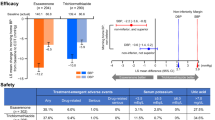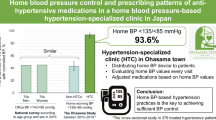Abstract
In the Japan Home versus Office Blood Pressure Measurement Evaluation (J-HOME) study, we examined the current situation with respect to the prescription of diuretics, including the prevalence of diuretic treatment and the dosages used for patients with essential hypertension in primary care settings. Of the 3,400 hypertensive patients included in the study, 315 (9.3%) patients (mean age: 66.9±10.4 years; males: 43.5%) were prescribed diuretics. Compared with patients who were not using diuretics, those who were using diuretics were more obese and had more complications. The most commonly prescribed diuretic among the 331 prescriptions in the 315 diuretic users was trichlormethiazide (44%), followed by indapamide (15%) and spironolactone (14%). Among patients being treated with diuretics, monotherapy was used in only 5% of patients; in the majority of patients combination therapy including diuretics (95%) was used. Relatively low dosages of diuretics were generally used. There was a difference between the actual dosages prescribed and those recommended by the Japanese Society of Hypertension (JSH) guidelines or the product information approved in Japan. Compared with previous estimates of the prevalence of diuretic use in hypertensives in Japan (4.0–5.4%), the rate in the J-HOME study (9.3%) was higher. This may be attributable at least in part to the results of the many published, large-scale intervention trials confirming the clinical significance of diuretics. Although a relatively high dosage is recommended in the diuretic product information and in the JSH guidelines, dosages of diuretics should be reconsidered in Japan.
Similar content being viewed by others
Article PDF
References
ALLHAT Officers and Coordinators for the ALLHAT Collaborative Research Group: Major cardiovascular events in hypertensive patients randomized to doxazosin vs chlorthalidone: the Antihypertensive and Lipid-Lowering Treatment to Prevent Heart Attack Trial (ALLHAT). JAMA 2002; 283: 2981–2997.
Xie F, Petitti DB, Chen W : Prescribing patterns for antihypertensive drugs after the Antihypertensive and Lipid-Lowering Treatment to Prevent Heart Attack Trial: report of experience in a health maintenance organization. Am J Hypertens 2005; 18: 464–469.
Katayama S, Inaba M, Morita T, Awata T, Shimamoto K, Kikkawa R : Blood pressure control in Japanese hypertensives with or without type 2 diabetes mellitus. Hypertens Res 2000; 23: 601–605.
Yamamoto Y, Sonoyama K, Matsubara K, et al: The status of hypertension management in Japan in 2000. Hypertens Res 2002; 25: 717–725.
Mori H, Ukai H, Yamamoto H, et al: Current status of antihypertensive prescription and associated blood pressure control in Japan. Hypertens Res 2006; 29: 143–151.
Ishikawa J, Kario K, Hoshide S, et al, on behalf of the J-MORE Study Group: Determinants of exaggerated difference in morning and evening blood pressure measured by self-measured blood pressure monitoring in medicated hypertensive patients: Jichi Morning Hypertension Research (J-MORE) Study. Am J Hypertens 2005; 18: 958–965.
Bhatt DL, Steg PG, Ohman EM, et al, for the REACH Registry Investigators : International prevalence, recognition, and treatment of cardiovascular risk factors in outpatients with atherothrombosis. JAMA 2006; 295: 180–189.
PROGRESS Collaborative Group: Randomized trial of a perindopril-based blood-pressure–lowering regimen among 6,105 individuals with previous storke or transient ischaemic attack. Lancet 2001; 358: 1033–1041.
Law MR, Wald NJ, Morris JK, Jordan RE : Value of low dose combination treatment with blood pressure lowering drugs: analysis of 354 randomised trials. BMJ 2003; 326: 1427–1434.
Inaba M, Noguchi Y, Yamamoto T, et al: Effects of a low dose of indapamide, a diuretic, given daily or every-other-day on blood pressure and metabolic parameters. Hypertens Res 2004; 27: 141–145.
Ohkubo T, Obara T, Funahashi J, et al, the J-HOME Study Group: Control of blood pressure as measured at home and office, and comparison with physicians' assessment of control among treated hypertensive patients in Japan: first report of the Japan Home versus Office Blood Pressure Measurement Evaluation (J-HOME) study. Hypertens Res 2004; 27: 755–763.
Obara T, Ohkubo T, Funahashi J, et al, the J-HOME Study Group: Isolated uncontrolled hypertension at home and in the office among treated hypertensive patients from the J-HOME study. J Hypertens 2005; 23: 1653–1660.
Imai Y, Otsuka K, Kawano Y, et al, the Japanese Society of Hypertension : Japanese Society of Hypertension (JSH) guidelines for self-monitoring of blood pressure at home. Hypertens Res 2003; 26: 771–782.
Japanese Society of Hypertension Guidelines Subcommittee for the Management of Hypertension : Guidelines for the management of hypertension for general practitioners. Hypertens Res 2001; 24: 613–634.
Japanese Society of Hypertension Guidelines Subcommittee for the Management of Hypertension : Japanese Society of Hypertension Guidelines for the Management of Hypertension (JSH 2004). Hypertens Res 2006; 29 ( Suppl): S1–S105.
SHEP Cooperative Research Group: Prevention of stroke by antihypertensive drug treatment in older persons with isolated systolic hypertension. Final results of the Systolic Hypertension in the Elderly Program (SHEP). JAMA 1991; 265: 3255–3264.
National Intervention Cooperative Study in Elderly Hypertensive Study Group: Randomized double-blind comparison of a calcium antagonist and a diuretic in elderly hypertensives. Hypertension 1999; 34: 1129–1133.
Joint National Committee on Prevention, Detection, Evaluation, and Treatment of High Blood Pressure: The Seventh Report of the Joint National Committee on Prevention, Detection, Evaluation, and Treatment of High Blood Pressure. JAMA 2003; 289: 2560–2572.
Flack JM, Cushman WC : Evidence for the efficacy of low-dose diuretic monotherapy. Am J Med 1996; 101 ( Suppl 3A): 53S–60S.
Hashimoto J, Hirayama H, Hanasawa T, et al: Efficacy of combination antyhypertensive therapy with low-dose indapamide: assessment by blood pressure self-monitoring at home. Clin Exp Hypertens 2005; 27: 331–341.
Chrysant SG : Fixed low-dose drug combination for the treatment of hypertension. Arch Fam Med 1998; 7: 370–376.
Carlsen JE, Kober L, Torp-Pedersen C, et al: Relation between dose of bendrofluazide antihypertensive effect, and adverse biochemical effects. BMJ 1990; 300: 975–978.
Ono A, Fujita T : Factors relating to inadequate control of blood pressure in hypertensive outpatients. Hypertens Res 2003; 26: 219–224.
Shinohara Y, Yoshimoto T, Fukuuchi Y, Ishigami S, The Joint Committee on Guidelines for the Management of Stroke : Japanesee Guidelines for the Management of Stroke 2004. Tokyo, Kyowa Kikaku, Ltd, 2004 ( in Japanese).
Author information
Authors and Affiliations
Consortia
Corresponding author
Rights and permissions
About this article
Cite this article
Murai, K., Obara, T., Ohkubo, T. et al. Current Usage of Diuretics among Hypertensive Patients in Japan: The Japan Home versus Office Blood Pressure Measurement Evaluation (J-HOME) Study. Hypertens Res 29, 857–863 (2006). https://doi.org/10.1291/hypres.29.857
Received:
Accepted:
Issue date:
DOI: https://doi.org/10.1291/hypres.29.857
Keywords
This article is cited by
-
Prescription status of diuretics for essential hypertension in a Japanese population
Hypertension Research (2021)
-
Adverse effect profile of trichlormethiazide: a retrospective observational study
Cardiovascular Diabetology (2011)
-
One-year effectiveness and safety of open-label losartan/hydrochlorothiazide combination therapy in Japanese patients with hypertension uncontrolled with ARBs or ACE inhibitors
Hypertension Research (2010)
-
Rationale, study design and implementation of the COLM study: the combination of OLMesartan and calcium channel blocker or diuretic in high-risk elderly hypertensive patients
Hypertension Research (2009)



